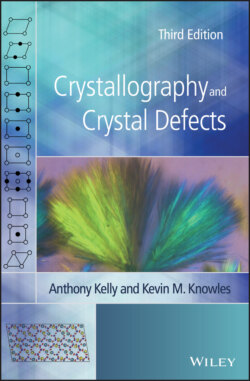Читать книгу Crystallography and Crystal Defects - Anthony Kelly - Страница 18
1.4.2 Rotational Symmetry
ОглавлениеIf one stood at the point marked H in Figure 1.1a and regarded the surroundings in a particular direction, say that indicated by one of the arrows, then on turning through an angle of 60° = 360°/6 the outlook would be identical. We say an axis of sixfold rotational symmetry passes normal to the paper through the point H. Similarly, at O′ an axis of threefold symmetry passes normal to the paper, since an identical outlook is found after a rotation of 360°/3 = 120°. A crystal possesses an n‐fold axis of rotational symmetry if it coincides with itself upon rotation about the axis of 360°/n = 2π/n radians. In crystals, axes of rotational symmetry with values of n equal to one, two, three, four and six are the only ones found which are compatible with translational symmetry. These correspond to repetition every 360°, 180°, 120°, 90° and 60° and are called monad, diad, triad, tetrad and hexad axes, respectively. The reasons for these limitations on the value of n are explained in Section 1.5.
